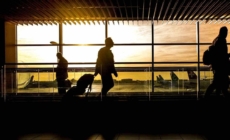-
Walmart Stabbing: Video Appears to Show Suspect Being Confronted - 9 mins ago
-
Blockbuster Mock Trade Sends Cardinals Stars To Phillies For Loaded Haul - 48 mins ago
-
Joaquin Nieman Reveals Open Reason For Axing Caddie, Coach - about 1 hour ago
-
MrBeast Makes Astronomer Joke After Gwyneth Paltrow Video - 2 hours ago
-
Kim Zolciak and Kroy Biermann move on amid messy divorce proceedings - 2 hours ago
-
Texas may rig election maps. Should California too? - 3 hours ago
-
Delta’s AI system will set personalized airfares for customers by year’s end - 3 hours ago
-
Gigantic Wooden City Being Built in Europe Will Be 2.7M Sq Ft in Size - 3 hours ago
-
Jay Leno reflects on political balance in comedy amid Colbert cancelation - 3 hours ago
-
Martin Brundle Offers Real Reason Behind Horner’s Red Bull Axe - 3 hours ago
Confusion surrounds Air India as crash dents national pride
Before one of its planes crashed just after takeoff last month, killing at least 260 people, Air India had been a symbol of the country’s global rise.
Only two years earlier, chief executive Campbell Wilson had inaugurated a brand-new Airbus A350, Air India’s first, calling it “a declaration of Indian aviation’s resurgence on the world stage.”
The aircraft’s delivery made headlines across the country, where the public cheered Air India’s transformation from a neglected state-owned flagship carrier into a modern airline that its new owners, the Tata Group, hoped would become the world’s biggest.
Under the Indian conglomerate, which founded the airline in 1932 and bought it back in 2022 after it spent decades under government operation, Air India was making big moves, announcing a record order in 2023 of 470 aircraft valued at more than $70 billion.
A year later, the airline said it had begun a $400 million retrofit of its legacy fleet, accelerating the upgrade by leasing jets from other airlines, including Delta.
That momentum came to a grinding halt last month when a London-bound Boeing 787 Dreamliner crashed seconds after takeoff in the northwestern Indian city of Ahmedabad, killing all but one of the 242 people aboard plus 19 others on the ground in one of India’s worst aviation disasters.
Air India has since been under immense pressure to answer for the crash, but bereaved families were left with more questions after investigators released a preliminary report this month that said the plane’s fuel switches had been wrongly cut off, leading to speculation that one of the pilots might have done it accidentally or even intentionally.
Indian investigators and the U.S. National Transportation Safety Board, which is involved in the crash investigation as the aircraft is U.S.-made, said such conclusions were irresponsible.
“Investigations of this magnitude take time,” NTSB Chairwoman Jennifer Homendy said, while India’s Aircraft Accident Investigation Bureau urged the public and the media to “refrain from spreading premature narratives.”
But Indian commentators were already irate.
“Why do this rumor mill mongering about possible problems with the pilot?” Arnab Goswami, a firebrand anchor, said on his conservative Republic Media Network. “So that across the world the impression goes that Indian pilots cannot fly?”
Capt. C.S. Randhawa, a former pilot for Air India and the Indian air force, said the suggestion that one of the pilots may have crashed the plane deliberately has “demoralized the pilots in the country.”
“All pilots are up in arms, and it’s not a good thing. The pilots have to fly with that mental attitude,” Randhawa, who is currently the president of the Federation of Indian Pilots, told NBC News.
The final report is due next year.
On top of the lack of clarity, some British families hoping to bury their loved ones said they had received the remains of the wrong people, according to the Daily Mail, which cited a lawyer representing them. The Indian foreign ministry said Wednesday that all remains were being handled with “utmost professionalism” and that it was working closely with the British side to address concerns.
Air India was also warned last week by India’s aviation regulator that it could face enforcement action over more than two dozen safety violations from this year and last year, Reuters reported, citing government notices. They include pilots not being given mandatory rest and poor compliance with simulator training requirements.
The airline, which voluntarily disclosed the problems last month, said Friday that it would respond to the regulator and that it “remains fully committed to ensuring the safety of its passengers and staff.”
Air India was already under enormous pressure to clean up its reputation after falling into disrepair during its nearly 70 years of government ownership. Its reform nevertheless aligned perfectly with Prime Minister Narendra Modi’s nationalist narrative of turning India into a global superpower.
“Given its legacy, the brand remains synonymous with India,” said Shelley Vishwajeet, a New Delhi-based aviation journalist and author of “The IndiGo Story,” a book about the Indian airline. He added that the cultural transformation within Air India “has been a challenge” for its new owners.
Things moved quickly after the takeover by the Tata Group, which consolidated several airlines it controlled, including Vistara and Air Asia India, into two entities: the full-cost carrier Air India and its budget arm, Air India Express.
Vistara, which was partly owned by Singapore Airlines, was particularly beloved by Indians, known for its modern planes and best-in-class customer experience. When it merged with Air India, travelers and crew hoped that Air India would be the true Vistara successor.
But Air India has struggled to deliver change as fast as some had hoped.
“They’re struggling with maintenance issues, disrepair issues, and all these things are taking time,” Randhawa said.
Source link































